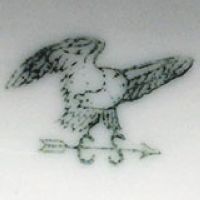
Image 011216-01-01
Used between 1906 and 1935, green eagle carrying an arrow and the initials "CS" for Carl Scheidig.
In the years before the successful businessman Carl Scheidig founded the new factory, quite few others had also been opened in the area, like for instance Weiß, Kühnert & Co. or the company of Unger, Schneider & Co. in Gräfenthal as well as the company of Leube & Co. in nearby Reichmannsdorf. Even if the area was ideal for such a business, many people thought that he did not stand a chance against such an opposition when he opened the final porcelain factory in or around Gräfenthal in 1906. But everybody close to Carl Scheidig knew he had not become such a successful businessman based on foolish decisions, and of course he had chosen the area carefully. The location itself was near a train station which allowed an easy delivery of raw materials and enabled the company to deliver their products to distributors all over Germany fairly easy. In addition, the large quantities of raw materials needed to supply the whole area made it cheaper for the single factory to cover its needs.
Basically creating a product range very similar to that of the surrounding companies, Scheidig carefully examined the catalogs available from the other facilities and slowly filled the nices left out by the other companies. It did not take long for the dealers, visiting the other companies in search for new items, found out that Scheidig offered a wide spectrum of products they had been looking for. Just as Scheidig had planned, the dealers stocked up at the other companies and then came around to visit him to complete their purchases - the whole area in and around Gräfenthal offered everything they needed. Soon designers and specialists from other facilities joined his company as they were attracted by the freedom of ideas and designs he offered; the factory already employed 160 people in 1913.
It took quite some time before the other companies noticed that Scheidig had started to issue free samples of his work every time the dealers called and had already received major contracts of dealers who had been convinced by the quality and designs. But it was too late to stop success and in 1925 he was able to take over the factory of Steinbrenner & Co. in Reichmannsdorf, which he kept running as a subsidiary to meet the growing demand. Backed by full order books, Scheidig specialized on figurines and group settings, resulting in a complete assortment of fabulous items which he also started to sell worldwide. Business went well and in 1930 the factory employed 250 workers, but just a few years later the company just managed to survive the second world war. Now under management by a board of directors, former trade lanes were reactivated one by one. With the founding of the German Democratic Republic in 1949 the whole business changed and export was restricted to socialist counties only.
Especially during the first few years, the leaders of the GDR had always claimed that their country was self-sufficient, but after the first years of the newly-born socialistic state it became more and more obvious that the state needed foreign currency. Based on the quite desperate situation of the state, every possible source had to be mobilized and in 1971, it was decided that a large-scale export plan was needed to achieve a higher flow in foreign currency. One of the most promising areas of interest was the vast array of porcelain and pottery facilities located in the country. Not only were there many well-known names present, the facilities also produced everything that was needed and sought after in other countries. Of course, the politicians were afraid that the involved companies not fully nationalized could fall back into 'capitalistic proceedings'. To avoid this, measures were instantly taken to ensure a total state control of all involved facilities and the year 1972 therefore saw the largest numbers of company nationalizations in the history of the GDR with one of these facilities of course being the Porzellanfabrik Carl Scheidig KG, which had until then still been a private company even if it was under state supervison.
After the company had been fully nationalized it was also made responsible for other minor facilities it its vicinity. As the name of the VEB indicates ('Porzellanfiguren' is German for 'porcelain figurines'), its primary objective was to concentrate on the figurine sector of the market, just like other combines did in their areas of interest. From the dawn of a new state in 1949 until 1972 many designs and molds slowly but surely were banned into the archives because of the changed market situation. But during the period of state ownership an even larger amount was dumped in the deep cellars of the factory simply because the factory had to focus on simpler items to achieve their planned output as they were much easier to produce and sell. Even if the pieces produced still had some of their old charme and are a class of their own, the dramatic overall decline is only too obvious as can also be seen in many other state-owned facilities during that period.
Shortly before November 9th 1989 (the fall of the Berlin wall) working conditions in Gräfenthal had deteriorated rapidly. Parts of the workforce saw the end of the state finally coming while others simply held against it that the whole situation was a propaganda plan to undermine the socialistic morale. Noticing the increasing pressure including the possibility of fights between the workers, the directors of the factory did the only reasonable thing and to avoid clashes between the different groups of workers, they ordered that the factory should be shut down and the people were sent home until the situation had simmered down.
After German reunification, the company started as a small limited company. In addition, they had started turning the factory in Reichmannsdorf into an industrial museum with funds supplied by the local government. During the first months, proceedings were very slow and they only survived by mostly selling products that had remained in Gräfenthal unfinished since the closure. The new proprietors knew that the desolate state of the factory had been caused by the constant neglect during the GDR era and it was only covering up the former glory.
Straight from the start a pair of employees had been assigned to dig out everything that was useful from the archives and finally after months of research the new owners were able to look back at the complete history of the facility. Absolutely everything a heart could desire was still there: catalogs, color sample books, decoration charts, photographs and even the old molds used to produce the old Scheidig figures. It was all there, undamaged, just waiting to be freed from a thick layer of dust and used once again.
The company owned an impressive product line of over 10,000 models. But all the money and time invested would not have been completed without a final name change: the company now proudly carried the name of Porzellanfiguren Gräfenthal GmbH vormals Scheidig KG in commemoration of its former owner.
However one can not live from former glory alone. After a long and unsuccessfuil struggle to reposition itself on the market the company had to file for insolvency proceedings, a process initiated on August 6th 2008. On May 18th 2009 the District Court of Jena finally declared termination of trade registration HRB 207476; this was published two days later.
During the period in which the factory was the main part of the VEB Porzellanfiguren Gräfenthal many figural items carried a special combination of marks: the older "Kronenadler" mark of Carl Scheidig was combined with a crown originally used by another part of the combine, Wagner & Apel. Items with this mark combination were created at the Gräfenthal factory, using former Wagner & Apel molds.

Image 011216-01-01
Used between 1906 and 1935, green eagle carrying an arrow and the initials "CS" for Carl Scheidig.
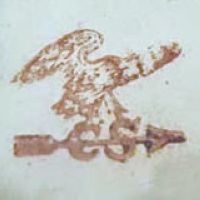
Image 011216-01-02
Used between 1906 and 1935, here the also common red version.
(Picture: Dianne Pickering)
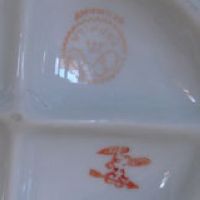
Image 011216-01-03
Used between 1906 and 1935, example of the previously shown mark together with the ERPHILA mark of Ebeling & Reuss of Philadelphia.
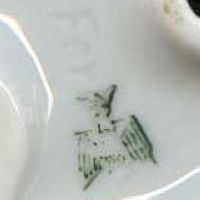
Image 011216-01-04
Used between 1935 and 1972, a stylized crowned eagle with "CS" on its chest, here smudged by the impressed "Foreign".
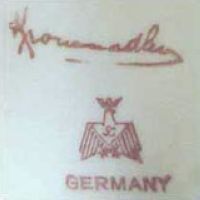
Image 011216-01-05
Used between 1935 and 1972, here with the trade name addition "Kronenadler" ("crowned eagle").
(Picture: Stephanie Harris)
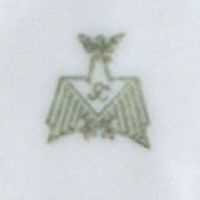
Image 011216-01-06
Used between 1935 and 1972, note the initials "CS" on its chest.
(Picture: Jeannine Wargacki)
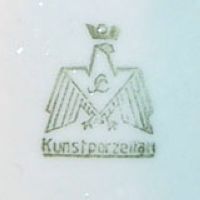
Image 011216-01-07
Used between 1935 and 1972, with the addition "Kunstporzellan". Green example.
(Picture: Marcus W. Brast)
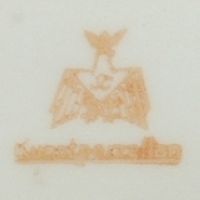
Image 011216-01-08
Used between 1935 and 1972, with the addition "Kunstporzellan". Red example.
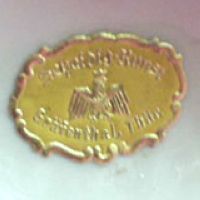
Image 011216-01-09
Used between 1935 and 1972, paper label with "Scheidig Kunst", the crowned eagle and "Gaäfenthal, Thür." (short for "Thüringen").
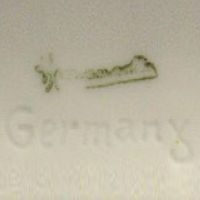
Image 011216-02-01
Used between 1972 and around 1980, the "Kronenadler" mark (here in green above impressed "Germany") can also be found together with ...
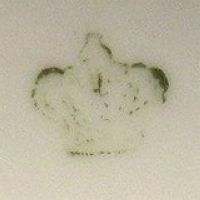
Image 011216-02-02
... a single crown, here also in green. See "Comment(s)" above.
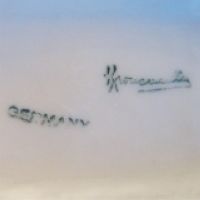
Image 011216-02-03
Used between 1972 and around 1980, another example: the "Kronenadler" mark above a stamped "Germany" in dark green ...
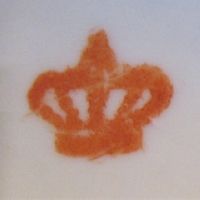
Image 011216-02-04
... but this time accompanied by a red crown. See "Comments(s)" above.
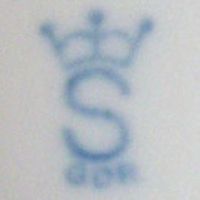
Image 011216-02-05
Used between 1972 and 1990, the crowned "S" over "GDR".
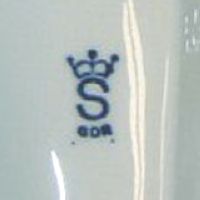
Image 011216-02-06
Used between 1972 and 1990, the crowned "S" over "GDR".
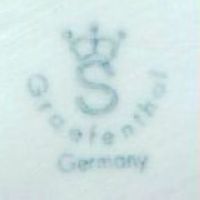
Image 011216-02-07
Used between 1985 and 1990, the crowned "S" over "Gräfenthal", note the addition stating "Germany".
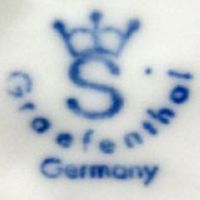
Image 011216-02-08
Used between 1985 and 1990, the crowned "S" over "Gräfenthal", note the addition stating "Germany".
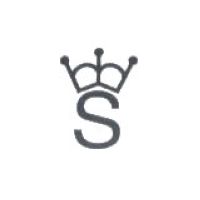
Image 011216-03-01
Used since 1990 until today.
© 2004-2025 C.S.Marshall, all rights reserved